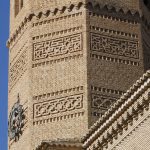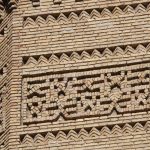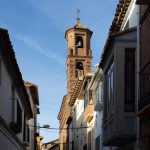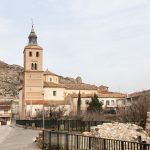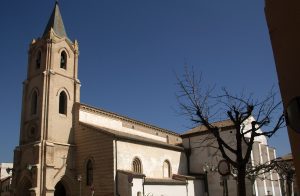

Monuments
THIS PROJECT PROVIDES AN UPDATED VISION OF THE MUDEJAR MONUMENTAL HERITAGE



Meeting point between the valley and the Altas Cinco Villas
Tauste is one of the historical Cinco Villas (Five Villages) of Aragon, and also had a significant population in the Islamic era. Proof of this is the Muslim necropolis found inside the town, one of the largest and oldest Muslim cemeteries on the Iberian Peninsula.
The best known and most visible emblem of the town is the Santa Maria church tower, an imposing octagonal-plan structure reaching a height of 46 meters, built of brick held together with plaster paste, which served as a beacon, guiding travelers along the old roads.
According to the description by Professor Borrás, the tower can be classified as Almohad minaret style with an exterior tower wrapped around an interior divided into rooms, forming a central buttress around which a staircase ascends, enclosed by false vaults consisting of narrowing courses of bricks.
The outer façades of the bell tower, which some scholars believe to have been a repurposed minaret from the town’s ancient mosque, are decorated with panels of protruding brick work in several patterns: intertwining round arches, panels of diamond shapes and octagonal four-sided interlacing motifs, to name a few.
The best known and most visible emblem of the town is the Santa Maria church tower, an imposing octagonal-plan structure reaching a height of 46 meters, built of brick held together with plaster paste, which served as a beacon, guiding travelers along the old roads.
According to the description by Professor Borrás, the tower can be classified as Almohad minaret style with an exterior tower wrapped around an interior divided into rooms, forming a central buttress around which a staircase ascends, enclosed by false vaults consisting of narrowing courses of bricks.
The outer façades of the bell tower, which some scholars believe to have been a repurposed minaret from the town’s ancient mosque, are decorated with panels of protruding brick work in several patterns: intertwining round arches, panels of diamond shapes and octagonal four-sided interlacing motifs, to name a few.
Tauste is one of the historical Cinco Villas (Five Villages) of Aragon, and also had a significant population in the Islamic era. Proof of this is the Muslim necropolis found inside the town, one of the largest and oldest Muslim cemeteries on the Iberian Peninsula.
The best known and most visible emblem of the town is the Santa Maria church tower, an imposing octagonal-plan structure reaching a height of 46 meters, built of brick held together with plaster paste, which served as a beacon, guiding travelers along the old roads.
According to the description by Professor Borrás, the tower can be classified as Almohad minaret style with an exterior tower wrapped around an interior divided into rooms, forming a central buttress around which a staircase ascends, enclosed by false vaults consisting of narrowing courses of bricks.
The outer façades of the bell tower, which some scholars believe to have been a repurposed minaret from the town’s ancient mosque, are decorated with panels of protruding brick work in several patterns: intertwining round arches, panels of diamond shapes and octagonal four-sided interlacing motifs, to name a few.
According to the description by Professor Borrás, the tower can be classified as Almohad minaret style with an exterior tower wrapped around an interior divided into rooms, forming a central buttress around which a staircase ascends, enclosed by false vaults consisting of narrowing courses of bricks.
The outer façades of the bell tower, which some scholars believe to have been a repurposed minaret from the town’s ancient mosque, are decorated with panels of protruding brick work in several patterns: intertwining round arches, panels of diamond shapes and octagonal four-sided interlacing motifs, to name a few.
Santa Maria church
Santa Maria church was built between the 13th and 14th centuries and exhibits, in general terms, the Gothic influence from the eastern coast of the Peninsula, which was quite widespread in this region by the late 13th century and assimilated by the Mudejar craftsmen due to the demands of their patrons. It has a single nave with chapels between the buttresses and the apse is polygonal on the exterior and semi-circular inside. It is covered with quadripartite rib vaults and the walls were originally finished with sgraffito and painted in bright colors. There are significant treasures in the interior.
The Mudejar is also present in the lower area of the town, where San Antón church is to be found. It has a combination Mudejar tower at the west end, meaning that the lower section is square and the upper part is octagonal, topped with a glazed tile spire. The tower dates from the 15th-16th centuries, although its gypsum foundations seem to have belonged to an older tower, perhaps a fragment of the city wall.
A stroll through Tauste also rewards visitors with some magnificent examples of Aragonese civil architecture made of brick, such as Casa de la Cámara, as well as views of the convent of the Order of St. Claire. A few kilometers away is the sanctuary of the Virgen de Sancho Abarca, at the gates of the Bardenas Reales nature park.
The Mudejar is also present in the lower area of the town, where San Antón church is to be found. It has a combination Mudejar tower at the west end, meaning that the lower section is square and the upper part is octagonal, topped with a glazed tile spire. The tower dates from the 15th-16th centuries, although its gypsum foundations seem to have belonged to an older tower, perhaps a fragment of the city wall.
A stroll through Tauste also rewards visitors with some magnificent examples of Aragonese civil architecture made of brick, such as Casa de la Cámara, as well as views of the convent of the Order of St. Claire. A few kilometers away is the sanctuary of the Virgen de Sancho Abarca, at the gates of the Bardenas Reales nature park.
Santa Maria church was built between the 13th and 14th centuries and exhibits, in general terms, the Gothic influence from the eastern coast of the Peninsula, which was quite widespread in this region by the late 13th century and assimilated by the Mudejar craftsmen due to the demands of their patrons. It has a single nave with chapels between the buttresses and the apse is polygonal on the exterior and semi-circular inside. It is covered with quadripartite rib vaults and the walls were originally finished with sgraffito and painted in bright colors. There are significant treasures in the interior.
The Mudejar is also present in the lower area of the town, where San Antón church is to be found. It has a combination Mudejar tower at the west end, meaning that the lower section is square and the upper part is octagonal, topped with a glazed tile spire. The tower dates from the 15th-16th centuries, although its gypsum foundations seem to have belonged to an older tower, perhaps a fragment of the city wall.
A stroll through Tauste also rewards visitors with some magnificent examples of Aragonese civil architecture made of brick, such as Casa de la Cámara, as well as views of the convent of the Order of St. Claire. A few kilometers away is the sanctuary of the Virgen de Sancho Abarca, at the gates of the Bardenas Reales nature park.
A stroll through Tauste also rewards visitors with some magnificent examples of Aragonese civil architecture made of brick, such as Casa de la Cámara, as well as views of the convent of the Order of St. Claire. A few kilometers away is the sanctuary of the Virgen de Sancho Abarca, at the gates of the Bardenas Reales nature park.
Information
City council: 976 854 950
tauste.es
Would you like to know more?
Turismo provincia de Zaragoza
www.turismodezaragoza.es
Comarca de Cinco Villas www.comarcacincovillas.es
Mudejar Territory Network
The city council has been a founding member of Territorio Mudéjar since September 13, 2018.
He is a member of the board of directors of the entity as a member.
Projects Mudéjar Territory in Tauste
Monuments | See the project
Pedagogy | See the project/
Mudetrad Project | See the project
Tauste in the social media
Facebook: @casadecultura.tauste
@oficinaturismotauste @CiviturTurismoCincoVillas
Instagram: @cultura_tauste @oficinaturismotauste
@civitur


